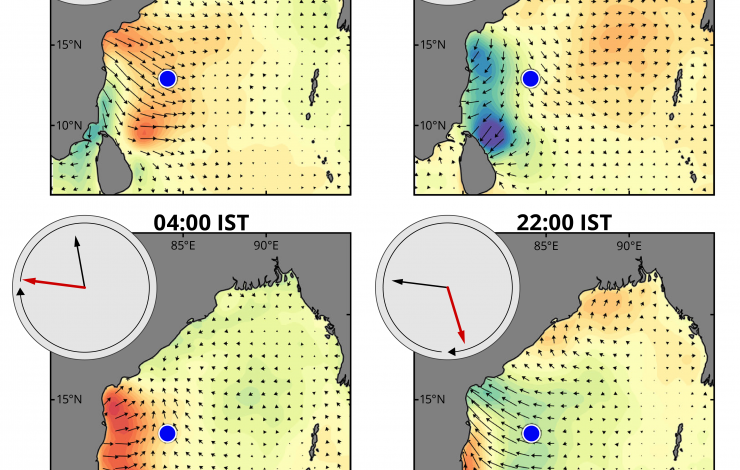
Land breeze wind vectors in the Bay of Bengal at four times of day (India Standard Time) for the average of July and August during the Southwest Monsoon. Red shading indicates winds that are stronger than the daily average and blue shading indicates winds that are weaker than the daily average. Inset shows surface currents (in red) and surface wind stress (in black) relative to the daily average at the location of the instrumented buoy (blue dot) for each of the four times.
McPhaden, M. J. K. Athulya, M. S. Girishkumar, and M. Orlić, 2024: Ekman revisited: Surface currents to the left of the winds in the Northern Hemisphere. Science Advances, 10, eadr0282, https://doi.org/10.1126/sciadv.adr0282.
Ekman's theory of wind-driven ocean currents on a rotating planet is central to our understanding of why surface currents are deflected to the right of the winds in the Northern Hemisphere and to the left of the winds in the Southern Hemisphere. The theory admits solutions for currents deflected in the opposite direction at periods shorter than the local inertial period, but Ekman did not mention these currents and they have only rarely been observed. This paper describes a prominent example of surface flow in the Bay of Bengal directed to the left of clockwise rotating land breeze wind forcing using multiple years of data from a long-term deepwater surface moored buoy. We further refine Ekman's theory so as to better reconcile it with our own and previous measurements, then conclude by discussing the broad implications of this work for understanding wind-forced ocean circulation.
The moored buoy used in this study is maintained by India's National Institute of Ocean Technology, a laboratory within the Ministry of Earth Sciences, one of many buoy systems in the Indian National Ocean Moored Buoy Network for the Northern Indian Ocean, or OMNI. This effort is coordinated with a parallel multi-national program led by NOAA and its partners, referred to as the Research Moored Buoy Array for African-Asian-Australian Monsoon Analysis and Prediction (RAMA). OMNI and RAMA provide Indian Ocean data for weather, climate and fisheries applications, and especially for monsoon forecasting.


